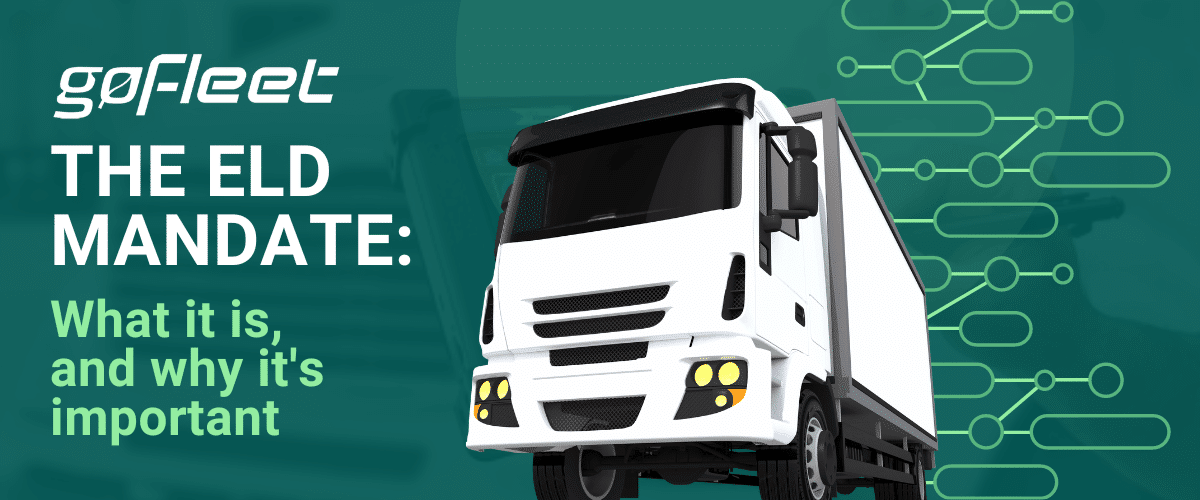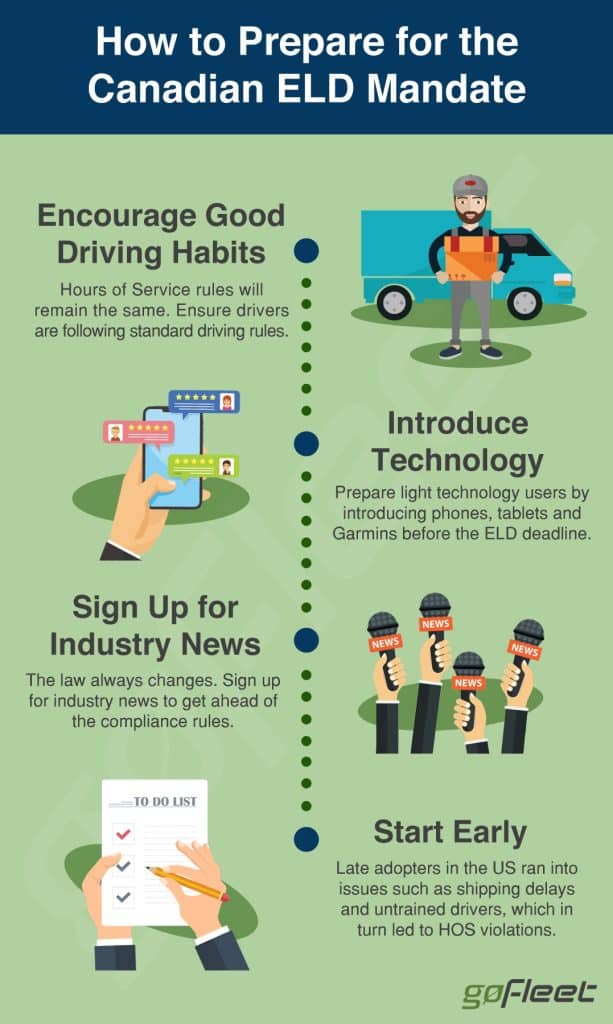The ELD Mandate is a game-changing regulation transforming the trucking industry and establishing new standards for compliance. The Electronic Logging Device (ELD) is a technological solution designed to accurately record and manage a commercial motor vehicle (CMV) driver’s Hours of Service (HOS). An ELD connects to a vehicle’s engine to automatically collect data on driving time, engine hours, vehicle movement, and miles driven. The primary purpose of implementing ELDs is to enhance safety on the roads by preventing fatigue-related accidents caused by drivers exceeding their allowable hours of service.
Both Canada and the United States have implemented regulations related to ELDs to ensure compliance and uniformity in the trucking industry. In the United States, the ELD mandate was established by the Federal Motor Carrier Safety Administration (FMCSA) and went into effect on December 18, 2017. The mandate requires CMV drivers to use approved ELDs to track and record their hours of service. Similarly, in Canada, the Electronic Logging Device (ELD) Mandate was introduced by Transport Canada and became effective on June 12, 2021. This mandate also requires CMV drivers to utilize compliant ELDs for recording their hours of service.
Compliance with the ELD mandate is of utmost importance for both drivers and carriers in the trucking industry. By adhering to the regulations, drivers can ensure they are not exceeding their allowable hours of service, which helps prevent fatigue-related accidents and promotes road safety. Additionally, complying with the ELD mandate allows carriers to enhance operational efficiency, streamline data collection, and reduce paperwork. Non-compliance with the mandate can result in penalties, fines, and even suspension of operations, underscoring the significance of embracing this technology and adhering to the regulatory requirements.
In this post, we will explore the key differences between the Canadian and American ELD mandates, delve into the technical requirements and certification processes, discuss the benefits of implementing ELDs in the trucking industry, and provide insights on how to choose the right ELD solution for your fleet. By understanding the ELD mandates in both countries and the importance of compliance, stakeholders in the trucking industry can navigate this regulatory landscape effectively while prioritizing safety, efficiency, and compliance.
Overview of the ELD mandate in Canada and the United States
The implementation of the Electronic Logging Device (ELD) mandate in both Canada and the United States represents a significant regulatory shift in the transportation industry. The mandates aim to improve road safety, enhance compliance with Hours of Service (HOS) regulations, and streamline the monitoring and recording of driver activity.
In the United States, the ELD mandate went into effect on December 18, 2017, as part of the Federal Motor Carrier Safety Administration’s (FMCSA) efforts to modernize the tracking of driver hours and increase safety on the roads. The mandate requires most commercial motor vehicle (CMV) drivers to use certified ELDs that meet specific technical standards. It applies to drivers who are currently required to maintain records of duty status (RODS) under HOS regulations.
The ELD mandate in the United States mandates that ELDs record and retain data regarding driving time, engine hours, vehicle movement, and other relevant information automatically. It ensures accurate tracking of a driver’s hours, duty status changes, and adherence to rest and break requirements. The ELDs must be registered and certified with the FMCSA to ensure they meet the required standards.
Similarly, in Canada, the ELD mandate came into effect on June 12, 2021, introduced by the Canadian Council of Motor Transport Administrators (CCMTA). The mandate applies to federally regulated motor carriers and requires them to use certified ELDs to capture and report driver HOS information. It aims to harmonize the ELD regulations across the country and improve compliance with HOS regulations.
Under the Canadian ELD mandate, ELDs must meet technical standards approved by the CCMTA. They must record driving time, on-duty time, off-duty time, and other required information accurately and reliably. The mandate sets guidelines for data transfer methods, device tampering prevention, and driver training on ELD usage.
Both the United States and Canada’s ELD mandates have specific timelines for compliance, exemptions, and provisions for enforcement. Fleet operators and drivers are required to understand the regulations, select certified ELDs, and ensure compliance with the respective mandates to avoid penalties and maintain operational efficiency.
Importance of compliance with the ELD mandate
Compliance with the Electronic Logging Device (ELD) mandate holds significant importance in the transportation industry, as it ensures adherence to Hours of Service (HOS) regulations, promotes road safety, enhances operational efficiency, and streamlines record-keeping processes. By mandating the use of ELDs, regulatory authorities in Canada and the United States aim to modernize and standardize the tracking and reporting of driver activities. Let’s delve into the specific importance of compliance with the ELD mandate and the benefits it brings to fleet operators and drivers.
Accurate HOS Compliance:
One of the primary objectives of the ELD mandate is to enforce accurate compliance with HOS regulations. By requiring the use of certified ELDs, regulatory authorities aim to eliminate the manual recording of driver activities and minimize the potential for errors or falsification of logbooks. ELDs automatically capture and store data related to driving time, rest periods, and breaks, ensuring accurate and reliable records. This promotes compliance with HOS limits, preventing excessive driving hours and reducing the risk of driver fatigue-related accidents.
Enhanced Road Safety:
Compliance with the ELD mandate significantly contributes to improving road safety. ELDs play a crucial role in preventing driver fatigue, a leading cause of accidents in the transportation industry. By accurately tracking and limiting the driving hours, ELDs help ensure that drivers take adequate rest breaks and comply with rest period regulations. This promotes driver alertness, reduces the likelihood of fatigue-related incidents, and enhances overall road safety for both drivers and other road users.
Streamlined Record-Keeping:
Manual record-keeping using traditional paper-based logbooks can be time-consuming, error-prone, and susceptible to tampering or falsification. Compliance with the ELD mandate streamlines record-keeping processes by automating data collection and storage. ELDs generate electronic logs that offer greater accuracy, transparency, and reliability compared to paper logs. This simplifies record-keeping for fleet operators, eliminates the need for manual calculations, and reduces the administrative burden associated with maintaining and reviewing paper logbooks.
Operational Efficiency:
ELDs bring significant benefits in terms of operational efficiency for fleet operators. By automating the recording and tracking of driver activities, ELDs provide real-time data on vehicle usage, driver availability, and HOS compliance. This enables fleet managers to make informed decisions regarding load assignments, route planning, and scheduling, optimizing resource allocation and reducing downtime. The accurate data provided by ELDs also facilitates better fleet management practices, allowing operators to identify inefficiencies, monitor driver performance, and implement strategies for improvement.
Compliance with Regulatory Requirements:
Complying with the ELD mandate is crucial for fleet operators to meet regulatory requirements and avoid penalties. Non-compliance with the mandate can result in fines, citations, or even the suspension of operations. By implementing certified ELDs and ensuring adherence to the regulations, fleet operators can demonstrate their commitment to safety, compliance, and accountability. It also provides a competitive advantage when bidding for contracts or working with clients who prioritize compliance standards.
Challenges and Considerations:
Implementing ELDs in Canada may present certain challenges that fleet operators should be aware of. Firstly, there may be an initial adjustment period for drivers and dispatchers as they adapt to the new technology and workflows. Proper training and education on ELD usage and functionalities can help alleviate these challenges. Additionally, there may be concerns regarding the cost of acquiring and installing ELD devices, as well as ongoing subscription fees for ELD services. However, it is essential to view these costs as investments in safety, compliance, and long-term operational efficiency.
Compliance with the ELD mandate also facilitates better data management and analysis. ELDs generate electronic logs that capture and store data in a standardized format. This data can be easily accessed and analyzed to gain valuable insights into driver behavior, performance, and operational patterns. Fleet operators can use this information to identify areas for improvement, optimize routes, and make data-driven decisions to enhance overall efficiency and productivity.
Furthermore, compliance with the ELD mandate can improve communication and collaboration within the industry. Since ELDs provide real-time data on driver availability and HOS compliance, it becomes easier for fleet managers and dispatchers to plan and allocate resources effectively. They can make informed decisions on load assignments, dispatching routes, and scheduling, ensuring efficient utilization of assets and reducing idle time.
Compliance with the ELD mandate also enhances accountability and transparency in the industry. Electronic logs generated by ELDs serve as reliable records that can be easily audited and reviewed. Authorities can quickly access and verify driver logs during inspections or investigations, ensuring compliance with regulations and deterring any attempts of logbook manipulation or falsification.
Moreover, compliance with the ELD mandate fosters a culture of safety within the organization. When fleet operators prioritize and invest in compliance, it sends a clear message to drivers that their safety and well-being are paramount. This can lead to a positive shift in driver behavior, increased awareness of HOS limits, and a collective commitment to upholding safety standards.












 [dm-embedable-media media-id=”22640″]
[dm-embedable-media media-id=”22640″]